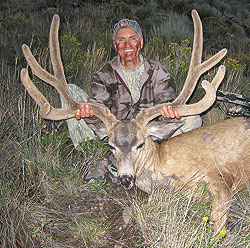October 28, 2010
By Randy Ulmer
 As a bowhunter, you need ways to tune your bow for maximum forgiveness. In-the-field shots are rarely as easy as those in your back yard, and there will invariably be minor changes in your shooting form. The Creep Test will help you tune some forgiveness into your bow to help compensate for those times when you pull too hard or not hard enough. |
In last month's column, I described the Creep Test and how to perform it. For those who didn't read that column, or for those of you with memories like mine, here's a brief description of the Creep Test: Stand at the line about 20 yards from the target, shoot one arrow pulling hard against the stops and then shoot another arrow creeped forward as much as possible. Make a note of where each of these arrows hit. Your ultimate goal is to get these two arrows to hit the same spot.
This is the Creep Test. The purpose of this test is to allow you to tune the high and low misses out of the bow. I find, on most bows, the creep test works best when the top cam rolls over ever-so-slightly ahead of the bottom cam as the bow comes to full draw. I do most of this fine-tuning by twisting one cable or the other to slightly alter its length, thus changing the associated cam's timing.
Advertisement
So, you are probably asking, what practical application does this have to me, the average bowhunter? Well, here's the take home message: First of all, you need to be very consistent with your draw length. You need to pull the bow back to the same place in the valley every time. If you could do that, the creep test would not matter. Unfortunately, none of us are that consistent.
In the previous column, I talked about shooting in the middle of the valley. I no longer advocate that. I feel you will be much more consistent with today's bows if you pull slightly (not hard) against the stops. The key to doing this well, as in all things related to shooting a bow, is to do it exactly the same way every time.
Advertisement
Keeping the above recommendations in mind, go out and shoot your bow. Get nice and warmed up. Now, using your best form and execution, shoot two arrows at 20 yards pulling firmly against the stops. Now shoot two arrows at the same spot while creeping forward as far as you comfortably can while still making a good shot.
If your arrows are more than two inches apart, you would probably benefit from a little fine-tuning. You can take the bow into the pro shop and have them sync the wheels. Or, if you are technically minded, you can do it yourself. As I said before, I start by timing the wheels so they both roll over at exactly the same time. You can check the wheels for synchronization by drawing your bow back while a friend watches the cams. Or, you can use a shooting machine or a bow-drawing jig to draw the bow back slowly while you concentrate on the cams.
To adjust the cams, place your bow in a bow press and twist one of the cables a 360-degree turn and reattach it. Try to make the upper cam come to full draw slightly ahead of the bottom cam. Repeat the creep test and compare the results. Be open minded as you are doing this. Be willing to go the opposite way if you are not getting the results you are looking for.
Adjusting the cams perfectly is easiest on a two-cam bow, slightly more difficult on a hybrid-cam system and hardest on a single cam. I am NOT saying that the ease of completing the creep test has anything to do with final shootability of these types of cams.
Back when I shot a single-cam bow, I had problems with the creep test, because I couldn't find an easy way to adjust highs and lows out of the system. I could get some results with tiller tuning (tightening and loosening the limb bolts one at a time) and then shooting to find the most forgiving setting (this will work on other types of cams as well).
Single-cam bows are probably easier to tune now because their nock travel has improved and they have developed very hard walls to keep the draw length exactly the same from shot to shot.
Some final thoughts: 1) Any time you twist or untwist a cable to change its length, you need to shoot the bow several times to allow the strings to settle in before you can fully trust the results of the change. 2) Bows that have fairly straight vertical nock travel seem to do better on the creep test than those that don't. 3) Do not pull too hard against the wall as it can be as detrimental to accuracy as creeping forward. Good Luck!
